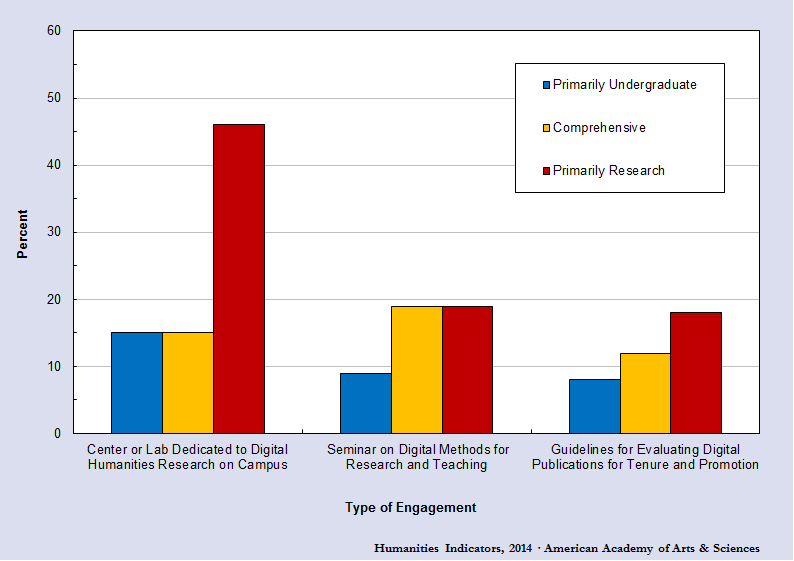Maybe the sky didn’t fall on the humanities after all.
The new edition of “The Humanities Indicators,” being released today by the American Academy of Arts and Sciences, suggests much more stability in humanities departments between 2007-8 and 2012-13 than is widely assumed to be the case. The findings come from surveys of humanities departments at four-year colleges and universities. Findings suggest only marginal shifts in the number of faculty slots and departments. (The indicators are a project designed to provide regular, reliable data on the state of the humanities.)
While that stability might cheer advocates for humanities programs, stability at a minimal level also seems to have been the case with regard to the digital humanities and evaluation of digital work for tenure and promotion. Despite considerable enthusiasm among many faculty members about digital humanities, the data show relatively few formal programs or policies.
Among the key findings related to departmental offerings and faculty positions:
- Across humanities disciplines, the number of departments was stable, with only modest declines in some fields. “A relatively small number of departments that had granted degrees in 2007-8 were no longer offering degrees in the subject five years later,” the report says. Declines ranged from 1 (out of 19) in history of science to 40 (out of more than 1,250) in languages and literatures other than English. In some cases (about 6 percent), departments were not eliminated but they are no longer offering all the degrees they offered.
- The number of faculty members was relatively unchanged.
- A majority of faculty members — relatively similar to the share in 2007-8 — were on the tenure track (or tenured). Less than a third of faculty members were employed part-time — again not much difference.
- Full-time faculty members (not all of whom are on the tenure track) taught about three-fourths of the students taking introductory courses, and 86 percent of non-introductory courses.
The report notes that many would expect the numbers to show more department closures and more reliance on adjuncts.
Robert B. Townsend, director of the academy’s Washington office, said he was surprised by the stability between 2007-8 and 2012-13. But he said that the indicators project collects data on two points in time, not everything that happened in between. It is possible, he said, that the data reflect “a return to the prior state after a sharp decline and then a rebound.” The first survey was conducted before the economic downturn hit in full force in the fall of 2008, and the second as many colleges and universities were starting to recover.
Digital Issues
At disciplinary meetings in the humanities, digital issues are much discussed. But the indicators survey was notable for not finding much embrace of digital humanities in the creation of centers or in tenure and promotion policies.
Only 24 percent of humanities departments had a center or lab focused on the digital humanities, and 15 percent of departments had at least one seminar or course on digital methods for research or teaching. And only 12 percent of departments had guidelines for evaluating digital publications in tenure and promotion.
As the above table shows, research universities are more likely than other sectors to have digital policies or programs in humanities departments, but such departments remain in the minority. There is some variation among humanities disciplines, but all without much wide adoption.
Townsend said that the minimal adoption of tenure and promotion guidelines represented a case of departments ignoring the urgings of many faculty members and their disciplinary associations.
He noted that both the Modern Language Association and the American Historical Association “have been promoting the need for guidelines on the evaluation of digital publications for tenure and promotion for almost 15 years now, so it is rather striking that 20 percent of English departments now have such guidelines, and just 9 percent of history departments.” He called those figures “rather sobering” for “anyone who thinks such guidelines are a necessary prerequisite to wider experimentation in the digital humanities.”


0 Comments